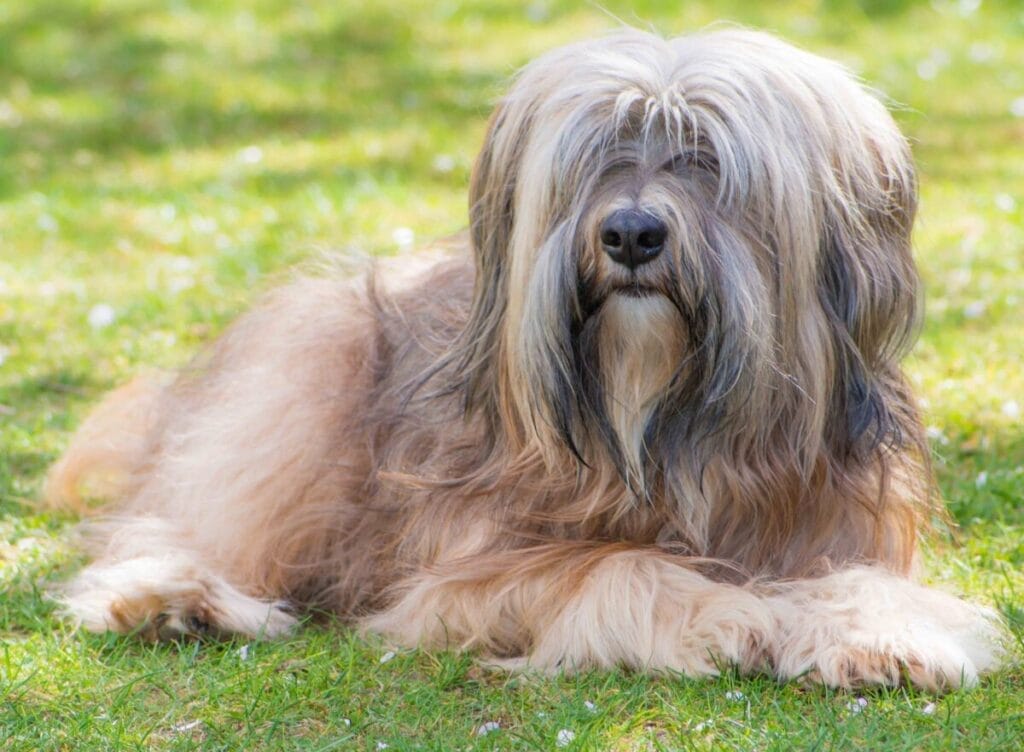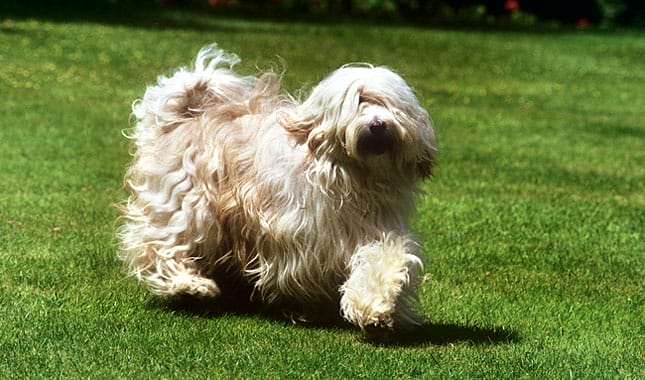Originally bred as a protective and obedient companion in Tibetan monasteries, the bright-eyed Tibetan Terrier we know today packs tons of affection and personality into its fluffy double coat. Though its name confusingly contains the word “Terrier”, it belongs to the non-sporting group and serves as an entirely loving housedog.
Introduction Tibetan Terrier Dog Breed
The Tibetan Terrier originated centuries ago in Tibet, where they served as protective companions and watchdogs for Tibetan monks. Despite its name, the breed belongs to the non-sporting group and serves solely as an affectionate housedog today. The “Terrier” name likely comes from their tenacity and spirited personality. Covered in a beautiful double coat that comes in many colors, lively, sensitive companion.
While energetic and spirited, Tibetan Terriers serve wonderfully as adaptable family pets. They boast very devoted bonds with their owners and love nothing more than being by their side. Their gorgeous coat needs extensive weekly grooming to prevent mats. With proper socialization and activity, these sensitive dogs thrive in homes with the right time and energy to give them.

Adaptability: ⭐⭐⭐⭐
Apartment Living: ⭐⭐⭐⭐⭐
Novice Owners: ⭐⭐⭐
Sensitivity: ⭐⭐
Alone Time: ⭐⭐
Cold Weather: ⭐⭐⭐⭐
Hot Weather: ⭐⭐⭐
Friendliness: ⭐⭐⭐⭐
Family: ⭐⭐⭐⭐⭐
Kids: ⭐⭐⭐⭐
Dogs: ⭐⭐⭐
Strangers: ⭐⭐⭐
Grooming Needs: ⭐
Shedding: ⭐
Drooling:⭐
Bathe/Brush: ⭐
General Health: ⭐⭐⭐
Weight Gain: ⭐⭐⭐
Size: ⭐⭐⭐
Trainability: ⭐⭐⭐
Ease of Training: ⭐⭐
Intelligence: ⭐⭐⭐⭐
Mouthiness: ⭐⭐
Prey Drive: ⭐⭐
Barking: ⭐⭐⭐
Wanderlust: ⭐
Exercise Needs: ⭐⭐
Energy Level: ⭐⭐
Intensity: ⭐⭐
Exercise Needed: ⭐⭐
Playfulness: ⭐⭐⭐⭐⭐
- Appearance: Medium-sized, square proportions, long silky coat, falls over eyes
- Lifespan: 12-15 years or more
- Temperament: Affectionate, sensitive, energetic, loyal
- Coat Colors: Black, white, gold, grey, cream, brown – often multi-colored
- Breed Group: Non-Sporting group
Tibetan Terrier Care
Food:
- High-quality commercial dog food
- 1.5 – 2 cups of dry food daily, divided
- Protein 25-28%, fat 12-15%
Environment:
- Closely bonded with family members
- Daily interactive playtime and walks
- Access to securely fenced yard

Grooming:
- Brush coat thoroughly 2-3 times a week
- Clip or hand-strip excessively long coat
- Clean folds near mouth to prevent infection
Preparing for a Tibetan Terrier Dog Breed
Tips:
- Time-intensive grooming requirements
- Sensitive nature demand gentle handling
- Will often bond most deeply with one person
Supplies:
- Pin brush and metal comb for grooming
- Variety of interactive toys
- Harness and 6ft leash for control
Health Concerns:
- Canine Hip Dysplasia: Have OFA certification done on breeding dogs
- Patellar Luxation: Ensure normal gait without limping
- Obesity: Don’t overfeed and provide ample exercise

Vaccines:
- Core vaccines: Distemper, adenovirus, parvovirus, rabies
- Elective vaccine: Bordetella (kennel cough)
Finding a Tibetan Terrier
- Popular Regions: Western Europe, North America
- Average Price: $1,200 – $1,600
Breed Rescues:
- Tibetan Terrier Rescue (U.S.)
- Tibetan Terrier Trust and Rescue (U.K.)

Adoption Considerations:
- General health screening
- Proper socialization testing
- Spay/neuter and vaccine record
Common Tibetan Terrier Names
Common themes include Tibet, etc:
- Bodhi, Karma, Lotus, Om, Zen
- Everest
- Tibbs, Sherpa, Tashi
How can I stop my Tibetan Terrier from biting?
Redirect biting onto chew toys, never hands. Ensure adequate exercise and enrichment. Use positive reinforcement training.
How should I socialize and train a friendly Tibetan Terrier?
Socialize extensively as a puppy in a posititive manner. Attend obedience classes using reward-based methods. Handle frequently.
How do I train?
Use positive reinforcement with food rewards and praise. Keep sessions short and engaging. Target sticks and clickers are very effective with this intelligent breed.
How often should I take my Tibetan Terrier to the vet?
Need annual wellness exams, vaccination boosters, dental cleanings, and illness exams as needed.
Do Tibetan Terriers make good family pets?
Yes, when properly exercised and socialized, make exceptionally loving and lively family companions able to thrive in homes with older, respectful children.
Are dogs good with kids?
Yes, tend to do very well with gentle, respectful children. Supervise young kids to prevent tail/ear pulling or roughhousing that could frighten this sensitive breed.
Are dogs good with other pets?
Yes, generally coexist very harmoniously with other dogs and cats, especially when raised together from puppyhood on. Use caution with small pets due to their terrier ancestry.
How smart is the Tibetan Terrier?
Highly intelligent, adept at learning cues, commands, and elaborate tricks with the right motivation and training.
What is the Tibetan Terrier’s lifespan?
The average lifespan is 12-15 years and often longer with proper preventative care, exercise, and nutrition.
Can Tibetan Terriers trigger allergies?
No dog is 100% non-allergenic but shed minimally. Their long coat does need extensive grooming to minimize shedding and associated allergens.
Are Tibetan Terriers aggressive dogs?
No, well-socialized have wonderfully devoted, friendly temperaments. They can be somewhat reserved with strangers but never intentionally aggressive.
Do Tibetan Terriers have hair loss issues?
No. Any hair loss should prompt veterinary examination for underlying causes like skin infections, parasites, or hormonal disorders.
By following our website, you can find the perfect dog breeds for you and provide them with the best possible dog care. Remember that owning a dog is a lifelong commitment that requires time, money, and patience. But it is also a rewarding experience that will bring you joy and companionship. All information in Dog care tips.

